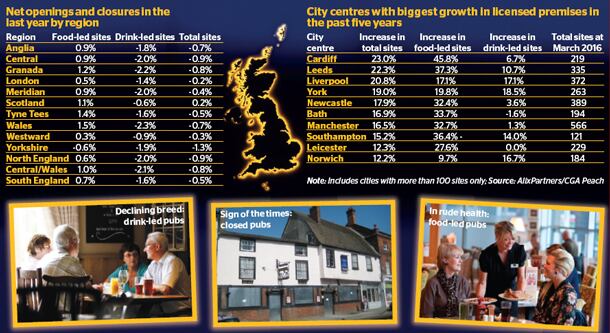Figures published last week demonstrate just how the eating and drinking out market has altered over the past five years in response to changing consumer demands.
The Market Growth Monitor from AlixPartners and CGA Peach showed that as of March 2016, the UK had 123,723 licensed premises — down 0.5% on the same period last year and down 4.4% on 2011. It equates to a net loss of 679 licensed premises in the past year.
The broad brush picture of the market is as it has been for many years, the report states, and will come as no surprise to licensees up and down the country: the bulk of the closures are drink-led pubs; the bulk of the openings are restaurants and casual dining brands in particular.

Decline
Britain’s stock of pubs and bars has fallen by 2.7% in the past year and by almost 10% over the past five years. In numerical term that’s 5,778 pubs and bars lost over that period — or three a day.
It’s a familiar tale of marginal drink-led community locals giving way to more food-driven businesses. Over the same periods food-led branded pubs grew 17.1% and a staggering 46.6%.
“A lot of these additions have been conversions of drink-led locals into eating-focused ones; Mitchells & Butlers’ rebadging of many Orchid pubs into its pub-restaurant brands is a good example of this,” the report states. “But there have been a healthy crop of new builds and retail unit conversions too.”
ALMR
Kate Nicholls, chief executive of the Association of Licensed Multiple Retailers, said the growth in food-led businesses demonstrated an innovative sector ready and willing to change with the times and lead the way with new concepts and trends.
“The figures highlight the changing attitudes of younger customers placing greater emphasis on food options and a shift towards food-led businesses.
“There appears to be a slowing-down in the rate of closures and signs of growth on the high street. Licensing hospitality, and branded eating-out venues in particular, have been integral drivers of growth throughout the UK. Continued competition and growth in the eating-out market is good for the UK economy and the growth in food-led businesses is encouraging for licensed hospitality.”
Cities
Regionally, the report shows that Cardiff has seen the biggest percentage increase in licensed premises over the past five years with a 23% hike, followed by Leeds (22.3%), Liverpool (20.8%), York (19%) and Newcastle (17.9%).
“Growth in regional cities is in part a consequence of the toughness of the London market.
“With competition so fierce and property costs so high, established operators have been looking well beyond the capital for their growth opportunities,” the report states.
Variation
The breakdown of increases in food-led and wet-led venues differed wildly among the growth hotspots.
While Cardiff’s 45.8% increase in food-led venues dwarfed the 6.7% rise on wet-led sites, in Liverpool there was an even split of 17.1% each. In Norwich (number 10 on the list) wet-led sites grew faster than food-led (16.7% vs 9.7%).
These cities are also witnessing the steady rise of smaller, dynamic operators — like those members of the PMA500 multiple operator club — with fewer than 25 sites, which are introducing new concepts and exciting eating out experiences.
